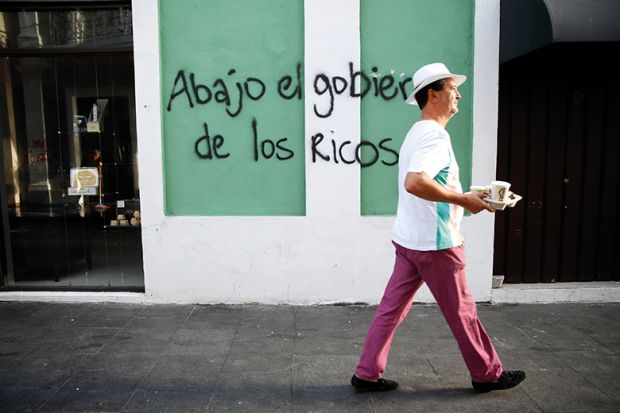On 15 July 2019, thousands of Puerto Ricans clashed with police officers in a street confrontation that lasted several hours and included fires, tear gas and makeshift barricades. At moments, the streets of Old San Juan resembled a war zone. The following day, the city walls were covered with anarchist slogans and circled As. While many people thought it was just a one-off brawl, the people’s demand for the resignation of Ricardo Rosselló became a multi-sectoral movement. Two weeks later, on 24 July, the territory’s governor announced that he would leave office in two weeks.
For some, the graffiti might have seemed just an expression of youthful exuberance. However, as Ruth Kinna demonstrates in The Government of No One, anarchism is a vibrant, centuries-old political philosophy.
What has come to be understood as “modern anarchism” emerged in the context of 19th-century Europe. Since then, it has proliferated across the globe, albeit modified or transformed to meet local needs. Popular misunderstanding may stem from the fact that anarchism is not composed of a single canon of thinkers or intellectual traditions. Rather, it is part of a constellation of cultures, conditions and prospects. Historically, anarchists have shared a set of goals and practices, but they also developed multiple, and often divergent, ideas about what an anarchist society should look like as well as how to achieve it.
Kinna’s book is an accessible introduction for those interested in exploring anarchism’s vast complexity and fluidity. Throughout, she focuses on the ways anarchists have interpreted some of the ideology’s most basic concepts and practices in different parts of the world. In doing so, she creates a dialogue of ideas across space and time. As she notes, the waves of 19th-century debates on how to bring about revolution and create new worlds continue to resonate in anarchist movements. However, it is also important to note that the historical conditions and systems of domination that anarchists face today can differ greatly. Thus, instead of considering solely how anarchism as an idea has been interpreted, Kinna also explores contemporary practices.
The book works well as an introduction – complete with tables, biographies and definitions – but it also contributes to anarchist historiography more broadly. Kinna presents an up-to-date analysis that includes theories of intersectionality (the analysis of multiple and interlocking forms of oppression), critical feminism, the events that took place in New Orleans after Hurricane Katrina and also the revolutionary organising happening in Kurdish Rojava.
The Government of No One will undoubtedly become obligatory reading for those who wish to learn about anarchism, as well as for scholars of radical politics in general. Here, Kinna joins the mostly male-dominated canon that has crafted comprehensive and far-reaching histories of anarchism over the past century, such as Max Nettlau (1865-1944), Daniel Guérin (1904-88) and Peter Marshall (born 1946). As the graffiti that were spray-painted in San Juan a few weeks ago demonstrate, anarchism is not a thing of the past but is very much alive. Kinna provides a guide for exploring the global cartography of contemporary anarchist organising, theorising and practice.
Jorell Meléndez-Badillo is currently Mellon faculty fellow at Dartmouth College, where he will serve as assistant professor of history from 2020.
The Government of No One: The Theory and Practice of Anarchism
By Ruth Kinna
Pelican
416pp, £20.00
ISBN 9780241396551
Published 1 August 2019
Register to continue
Why register?
- Registration is free and only takes a moment
- Once registered, you can read 3 articles a month
- Sign up for our newsletter
Subscribe
Or subscribe for unlimited access to:
- Unlimited access to news, views, insights & reviews
- Digital editions
- Digital access to THE’s university and college rankings analysis
Already registered or a current subscriber? Login






